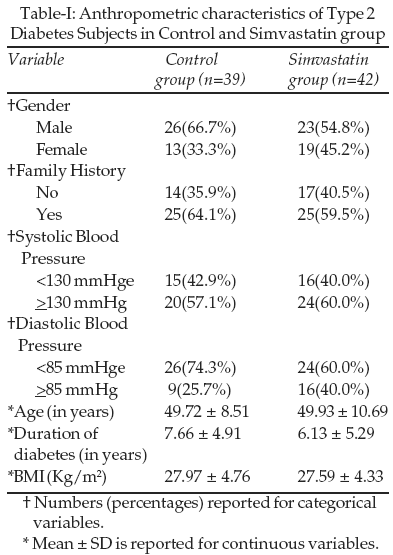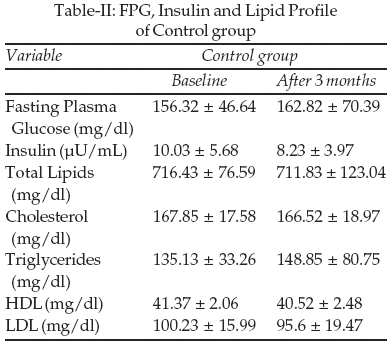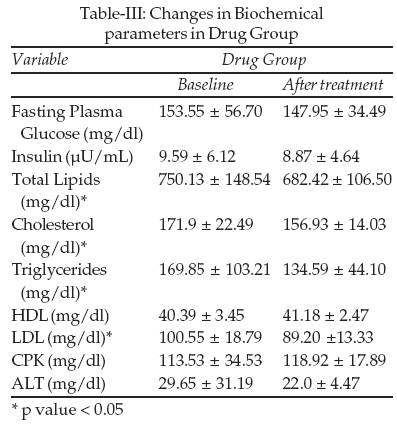|
|
||||
|
Published by : PROFESSIONAL MEDICAL PUBLICATIONS |
||||
|
ISSN 1681-715X |
||||
|
||||
|
- |
||||
|
ORIGINAL ARTICLE |
||||
|
- |
||||
|
Volume 23 |
October - December 2007 (Part-I) |
Number 5 |
||
|
|
||||
|
||||
|
|
||||
|
Published by : PROFESSIONAL MEDICAL PUBLICATIONS |
||||
|
ISSN 1681-715X |
||||
|
||||
|
- |
||||
|
ORIGINAL ARTICLE |
||||
|
- |
||||
|
Volume 23 |
October - December 2007 (Part-I) |
Number 5 |
||
|
|
||||
|
||||
Effect of simvastatin on insulin sensitivity
in type 2 diabetic subjects
M. Zafar Iqbal Hydrie1, Rashida Qasim2,
M. Yakoob Ahmadani3,
Zahid Miyan4, Asher Fawwad5, Abdul Basit6
ABSTRACT
Objective: To study the effect of Simvastatin therapy on insulin sensitivity in type 2 Diabetes mellitus subjects.
Methodology: This is a randomized case control study, conducted at Baqai Institute of Diabetology and Endocrinology, Karachi, Pakistan. The study was conducted in 100 type 2 diabetes subjects of both sexes. Patients were randomized into two groups. Fifty patients were given Simvastatin 40mg/day for three months while 50 patients were used as controls. Both groups had similar anthropometric (age, duration of diabetes, BMI and Blood pressure) and biochemical (serum creatinine, fasting plasma glucose, fasting insulin level and lipid profile) characteristics. Insulin resistance was assessed by calculating homeostasis model assessment for insulin resistance (HOMA-IR) before and after 3 months of simvastatin treatment (40mg/day).
Results: Simvastatin (40mg/day) markedly decreased cholesterol, triglycerides and LDL levels but did not significantly affect insulin sensitivity as determined by HOMA-IR. However it improved insulin sensitivity in subjects having insulin resistance. (HOMA IR reduction 1.92; p=0.001)
Conclusion: Short term simvastatin therapy (3 months) had no effect on insulin sensitivity, but had a significant lipid lowering effect in all the subjects.
KEY WORDS: Diabetes, Insulin sensitivity, Lipid profile, Simvastatin.
Pak J Med Sci October - December 2007 (Part-I) Vol. 23 No. 5 755-759
1. Dr. M. Zafar Iqbal Hydrie, M Phil,
Research Officer, Research Department,
2. Prof. Rashida Qasim, PhD
Chairperson, Z.A School of Medical Technology,
Sindh Institute of Urology & Transplantation,
Karachi - Pakistan.
3. Dr Muhammad Yakoob Ahmadani, FCPS
Assistant Professor of Medicine, Dept. of Medicine,
4. Dr Zahid Miyan, MCPS
Senior Registrar,
5. Dr. Asher Fawwad, MPhil,
Research Officer, Research Department,
6. Prof. Abdul Basit, FRCP
Professor of Medicine, Head of Department,
Medical Unit - IV, Baqai Medical University, Director,
1,6: Baqai Institute of Diabetology and Endocrinology,
Plot 1-2, II-B, Block 2, Nazimabad-2,
Karachi-74600, Pakistan.
Correspondence
Dr. Asher Fawwad, MPhil,
Email: bideresearch@hotmail.com
* Received for Publication: December 6, 2006
* Revision Received: December 27, 2006
* Received Accepted: July 2, 2007
INTRODUCTION
Diabetes affected 194 million people worldwide in 2003 and is estimated to affect 299 to 333 million people by 2025, according to the International Diabetes Federation (IDF) Diabetes Atlas.
1 Pakistan is sixth in the world with 6.2 million diabetes subjects in 2003 and will be fourth in 2025 with 11.6 million diabetic subjects.1 Insulin resistance is supposed to play a major role in the development of Diabetes. The precise way in which insulin resistance develops in type 2 diabetes is unclear, although genetics, diet and level of physical activity are believed to play a role.2Various studies have observed the effect of HMG-Co-A reductase inhibitors (Statins) on insulin sensitivity in type 2 diabetic subjects.
3-7 Two separate studies using simvastatin and atorvastatin reported that statins improved insulin action in type 2 diabetic subjects.3,4 While other studies did not observe any favourable effects of statins on insulin action in type 2 diabetes.5-7Since Statins are commonly used for the treatment of hypercholesterolemia in clinical practice, it is important to know their effect on insulin sensitivity.
8 If further studies confirm the observation that statins improve insulin sensitivity and reduce the onset of type 2 diabetes, the perceived benefit of cardiovascular interventions in clinical trials could be greatly increased and the long term cost – benefit analysis of these interventions may be more positive than previous studies have estimated.9-11Thus our aim was to investigate whether Simvastatin (40mg/day) therapy for three months could have an effect on insulin sensitivity as determined by Homeostasis Model Assessment (HOMA-IR) in type 2 diabetes subjects.
SUBJECTS AND METHODS
This was a randomized, case control study of type 2 diabetes subjects at Baqai Institute of Diabetology and Endocrinology (BIDE), a tertiary care centre. Ethical approval for the study was obtained from the institutional ethical review board. A total of 100 type 2 diabetic subjects were selected from the OPD of BIDE. The purpose and procedures of the study were explained to all the subjects. The patients were randomized into one of the two groups; 50 subjects were given simvastatin 40mg per day for three months while 50 subjects were used as controls. Patients already using metformin or antihypertensive drugs continued their medication but the dose was fixed for the duration of the study.
Inclusion criteria: Type 2 diabetes, more than 30 years of age and having Blood pressure less than 140/90mmHg.
Exclusion criteria: Serious heart, liver or kidney problems, history of renal transplant, recent history of drug or alcohol abuse, pregnant or plan to become pregnant during the study period, using insulin, using steroids or statins, LDL levels greater than 130mg/dl and serum creatinine greater than 1.5mg/dl .
Data collection: Height, weight, BMI and blood pressure measurements were done and other information collected with the help of a pre designed questionnaire.
Biochemical parameters: Fasting blood glucose, fasting insulin, fasting lipid profile (cholesterol, triglyceride, HDL, LDL), were done by the standard methods using stat fax 1904 by mosquito and ELISA 303 by sandwich technique. Serum creatine kinase and Alanine-amino transeferase (ALT) levels were also measured before and after the study.
Assessment of insulin sensitivity:
Insulin sensitivity was assessed by calculating Homeostasis model assessment (HOMA-IR) as follows:Insulin (mu/ml) glucose (mmol/l)/22.5. Effect of simvastatin on insulin sensitivity was classified as no effect, increase and decrease of HOMA-IR values after three months treatment.
Statistical Analysis:
Statistical analysis was performed using SPSS 10 version for windows. Independent samples T test (for continuous variables) and Chi square test (for categorical variables) were used to compare the baseline characteristics between drug and control groups. Paired Sample T test was used for estimating statistical significance of differences in means before and after the treatment of continuous variables.RESULTS
Table-I shows the anthropometric and biochemical characteristics of the subjects in the control and simvastatin treated groups at the start of the study. The proportion of male and female in both the groups was similar. Proportions of subjects having positive family history of diabetes and blood pressure in both the groups were also similar. Both groups had similar ages, duration of diabetes, body mass index and serum creatinine levels.

Table-II shows the mean values of the biochemical parameters done at start and end of study (after three months) in the control group. Table-III shows the value of the biochemical parameters done at start and end of study (after three months of simvastatin treatment). Significant reduction was found in total lipids, cholesterol, triglycerides and LDL levels before and after treatment with Simvastatin [40mg/day] (p value =0.003, p value <0.001, p value =0.013 and p value = 0.003 respectively). There was no adverse effect on muscle or liver as was evident by no change in CPK and ALT values before and after treatment (p value = 0.351 and p value = 0.146).

Effect of Simvastatin on Insulin sensitivity: No statistically significant difference on HOMA-IR value was observed in the group treated with simvastatin. We further assessed the effect of simvastatin on insulin sensitivity in type 2 diabetes subjects by selecting only the insulin resistant type 2 diabetes subjects. The reference cut-off value for diagnosis of insulin resistance in type 2 diabetes mellitus was taken as 2.8 as suggested by Matthews, et al.
12 Thus all those subjects who had a HOMA – IR value of more than 2.8 at the start of the study were selected. A total of 20 subjects were identified in this group. They had a mean HOMA – IR of 5.74 at the start of the study and a mean HOMA – IR of 3.82 after 3 months of simvastatin therapy. A HOMA-IR reduction of 1.92 was noted which was statistically significant [p value = 0.001].

DISCUSSION
Clinical studies have reported the positive effect of statins on insulin sensitivity in type 2 diabetic subjects.
3,4 Stewart et al and Farrer M, et al found no effect of statins on insulin sensitivity.5,7 The euglycemic hyperinsulinemic clamp technique is the ‘‘gold standard’’ method in determination of peripheral insulin sensitivity and was used in various studies.5,6 Recent studies have used the HOMA–IR which is a good method for measurement of insulin sensitivity and is comparable to the euglycaemic glucose clamp technique.13,14Farrer M, et al. found that simvastatin decreases plasma triglyceride concentration but they did not find any significant change in fasting plasma glucose, insulin levels and HbA1c in type 2 diabetic subjects.
7 These findings are very much similar to our results; we also found no significant change in insulin sensitivity while significant change in lipid profile was seen by giving 40mg/day of simvastatin for three months.Several epidemiological studies have demonstrated the relationship between insulin resistance and dyslipidemia.
16 The CARDIA Study looked at insulin and lipid levels in black and white young adults; they reported a positive relationship between plasma insulin and triglyceride concentration among both racial groups.16 Similarly in 1992, the French Telecom Study compared characteristics of the insulin resistance syndrome in Caribbeans and Caucasians and they found that higher insulin concentrations in the Caribbean group were associated with higher levels of triglyceride after adjustment for age and BMI.17 Paolisso G, et al observed that statins administration was associated with an improvement of insulin resistance and decline in plasma triglyceride concentrations.3 Thus the lipid lowering effect of statins on plasma triglyceride in our study may improve insulin sensitivity as was noted by the reduction in fasting insulin levels but this was not statistically significant. This may become more evident if the effect is observed after a long duration of time.In our study, simvastatin therapy (40mg/day) for three months effectively decreased cholesterol, triglycerides & LDL levels but did not cause any statistically significant change in insulin sensitivity. If those type 2 diabetes subjects who had a HOMA-IR value of more than 2.8 and having insulin resistance as described by Matthews DR, et al.
12 were selected; they had a statistically significant reduction in insulin resistance of 1.92 HOMA-IR (p value = 0.001). This indicates that although simvastatin did not affect all type 2 diabetes subjects but it improved insulin sensitivity in a selected group of type 2 diabetes subjects who were insulin resistant at the start of the study.CONCLUSION
It is concluded from the present study that short-term (3 months) simvastatin therapy had no effect on insulin sensitivity, but had a significant lipid lowering effect in all the subjects. Further long term studies in large populations are needed to assess the effect of statins on insulin sensitivity.
REFERENCES
1. IDF Diabetes Atlas 2nd Edition, 2003. International Diabetes Federation, Brussels, 2003.
2. Reaven GM. Syndrome X: 6 years later. J Intern Med Suppl 1994;736:13-22.
3. Paolisso G, Sgambato S, De Riu S, Gambardella A, Verza M, Varricchio M, et al. Simvastatin reduces plasma lipid levels and improves insulin action in elderly, non insulin dependent diabetics. Eur J Clin Pharmacol 1991;40(1):27-31.
4. Paolisso G, Barbagallo M, Petrella G, Ragno E, Barbieri M, Giordano M, et al. Effects of simvastatin and atorvastatin administration on insulin resistance and respiratory quotient in aged dyslipidemic non-insulin dependent diabetic patients. Atherosclerosis 2000;150(1):121-7.
5. Stewart MW, Dyer RG, Alberti KGMM, Laker MF. The effects of lipid lowering drugs on metabolic control and lipoprotein composition in type 2 diabetic patients with mild hyperlipidemia. Diabetic Med 1995;12:250-7.
6. Hwu CM, Kwok CF, Chen HS, Shift KC, Lee SH, Hsiao LC, et al. Lack of effect of simvastatin on insulin sensitivity in type 2 diabetic patients with hypercholesterolamia: Results from a double-blind, randomized, placebo-controlled crossover study. Diabet Med 1999;16:749-54.
7. Farrer M, Winocour PH, Evans K, Neil HAW, Laker MF, Kesteven P, et al. Simvastatin in non-insulin- dependent diabetes mellitus: effect on serum lipids, lipoproteins and haemostatic measures. Diab Res Clin Pract1994;23:111-9.
8. Kazumi T, Yoshino G, Ohki A, Matsuba K, Ino T, Amano M, et al. Simvastatin Study Group. Long-term effects of simvastatin in hyper-cholesterolemic patients with NIDDM and additional atherosclerotic risk factors. Horm Metab Res1995;27:239-43.
9. Scandinavian Simvastatin Survival Study Group: Randomized trial of cholesterol lowering in 4444 patients with coronary heart disease the Scandinavian Simvastatin Survival Study (4S). Lancet 1994;334:1383-9.
10. Shepard J, Cobbe SM, Ford I. The West of Scotland Coronary Prevention Study Group: prevention of coronary heart disease with pravastatin in men with hypercholesterolemia. N Engl J Med 1995;333:1301–7.
11. Pyorala K, Pedersen TR, Kjekshus J. Scandinavian Simvastatin Survival Study (4S) Group. Cholesterol lowering with simvastatin improves prognosis of diabetic patients with coronary heart disease: A subgroup analysis of the Scandinavian Simvastatin Survival Study (4S). Diabetes Care 1997;20:614-20.
12. Matthews DR, Hosker JP, Rudenski AS. Homeostasis model assessment: insulin resistance and b-cell function from fasting plasma glucose and insulin concentration. Diabetologia 1985;28:412-9.
13. Fukushima M, Taniguchi A, Sakai M. Assessment of insulin sensitivity: comparison between simplified evaluations and minimal model analysis. Diabetes Care 2000;23:1038-9.
14. Mather KJ, Hunt AE, Steinberg HO. Repeatability characteristics of simple indices of insulin resistance: implications for research applications. J Clin Endocrinol Metab 2001;86:5457-64.
15. Ohrvall ML, Lithell H, Johansson J, Vessby B. A comparison between the effect of gemfibrozil and simvastatin on insulin sensitivity in patients with non-insulin dependent diabetes mellitus and hyperlipoproteinemia. Metabolism 1995;44:212-7.
16. Manolio TA, Savage PJ, Burke GL, Liu K, Wagneknecht LE, Sidney S, et al. Association of fasting insulin with blood pressure and lipid in young adults. Arteriosclerosis 1990;10:430-6.
17. Fontbonne A, Papoz L, Eschwege E, Roger M, Saint-Paul M, Simon D. Features of insulin-resistance syndrome in men from French Caribbean Islands. The Telecom Study. Diabetes 1992;41(11):1385-9.
HOME | SEARCH | CURRENT ISSUE | PAST ISSUES
Professional
Medical Publications
Room No. 522, 5th Floor, Panorama Centre
Building No. 2, P.O. Box 8766, Saddar, Karachi - Pakistan.
Phones : 5688791, 5689285 Fax : 5689860
pjms@pjms.com.pk